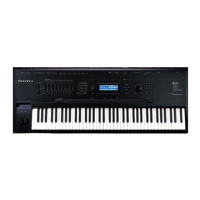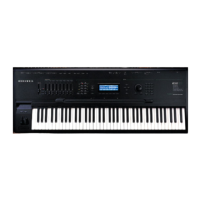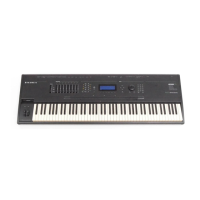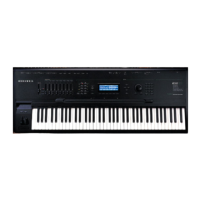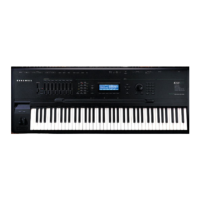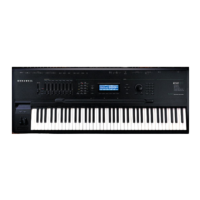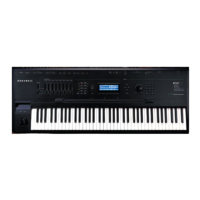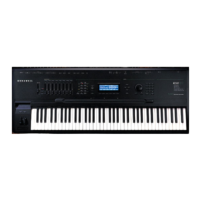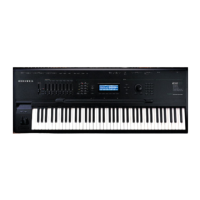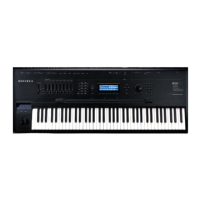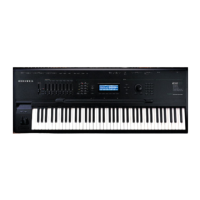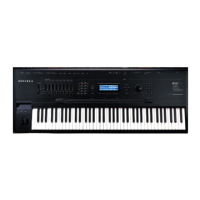Sampling and Sample Editing
Reading Samples
15-35
the sample information. Programs are identified by the suffix “.p,” and are stored in program
RAM. Samples have the suffix “.s,” and are stored in sample RAM. You can press Cancel to
return to the Disk mode page without loading the volume.
If you load sample objects, you’ll see the following prompt: “Create preview program/
keymap?” If you answer Yes, the K2500 will load the samples into a program that it creates
based on Layer 1 of Program 199. Loading program objects will load multi-layer samples and
keymaps, and sometimes velocity switches. The K2500 will create layers as necessary when you
load program objects. These layers have the same settings as Layer 1 of Program 199. In some
cases, the K2500 will also create stereo keymaps to preserve the separation of stereo samples.
If you press the File button, the prompt will change to “File to load:” You can view the list of
files with the cursor buttons, or use numeric entry. The top line of the display will show the
currently selected volume. Select different volumes with the Layer buttons. The size of the
currently selected file, in Kilobytes, is shown just above the soft buttons on the left. Press the
OK button to load the highlighted file.
Press OK, and the Bank dialog will appear. Press OK again, and the file will be loaded into the
highlighted bank.
Sometimes you may find an Akai floppy disk that your K2500 can’t read. In this case, check the
format of the disk. Akai allows you to format a double sided-double density (DD) disk for high
density (HD). This is not standard in the computer industry, since DD disks are not verified for
use as HD disks. If this is the case, you will need to load the disk into an Akai, then save it out
to a properly formatted disk.
Roland
For Roland disks, the hierarchy is a bit different; the objects that can be loaded are called
Volumes, Performances, Patches, and Samples. The page that was selected last time a SCSI load
was executed will appear when you initiate the load operation. Following the prompt is the list
of available objects, with the size of the object in Kilobytes displayed as well. The top line of the
display will show the number of available objects of the selected type.
Use the soft buttons to highlight the object to be loaded. The layer buttons will take you
through the current object list in increments of 100. Press OK to execute the load. The Bank
dialog will appear. Press OK again, and the object will be loaded. The display will update you
on the progress of the load.
EPS
For EPS disks, the hierarchy consists of files and directories. Directories can be nested several
layers deep. When you press the Load soft button, you’ll be prompted to select a file or
directory to load from the list of available files and directories. The currently highlighted object
will be either a file or a directory. If it’s a file, its name and size will be shown following the
prompt. If it’s a directory, its name appears, followed by “(dir)” to indicate its type. The Layer
buttons will take you to the first and last files of the currently selected directory. Note that if
you’re loading from floppy disks, you won’t see any of the displays or soft buttons relating to
directories, since the directory architecture is not supported for floppies.
When a file is highlighted and you press OK, the Bank dialog appears; press OK again to load
the file. When a directory is highlighted and you press OK, you enter that directory, and the list
of files and subdirectories in that directory appears, each file followed by its size, and each
subdirectory, if any, followed by “(dir).” The top item in every list you select is always the
parent directory of the files below it. Select the top item in a list to go up one directory level.
Pressing the Exit soft button will take you one level back up the hierarchy. Pressing it
repeatedly will take you to the root directory—the directory at the top of the hierarchy. The
quickest way to the root directory is to press the Root soft button. The top line of the display
shows you the name of the currently selected directory (or subdirectory). Pressing the All soft
button will load all files in the current directory (but not any subdirectories). The Bank dialog
will appear, and when you press OK, you’ll be prompted to press the Progs button to load
program information in addition to the samples, or the Samps button to load only the samples.
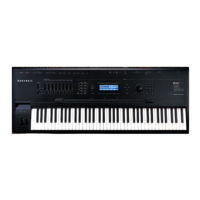
